Renewable energies are those sources of energy that can be obtained naturally without depleting the planet’s resources. Hybrid renewable energy systems are those that combine two or more renewable energy sources to generate electricity.
- hybrid renewable energy systems
- battery energy storage system
- optimization techniques
- optimization algorithms
1. Introduction
2. Renewable Energy Hybrid Systems
2.1. Composition of HRESs
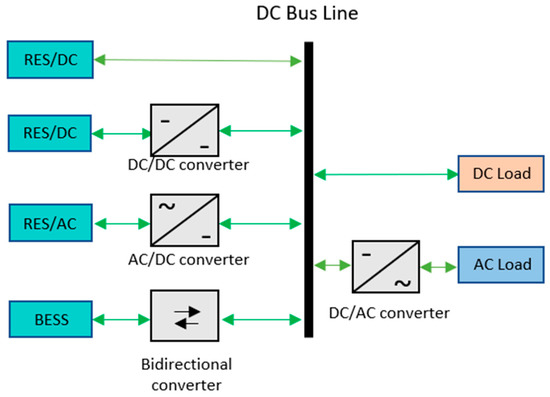
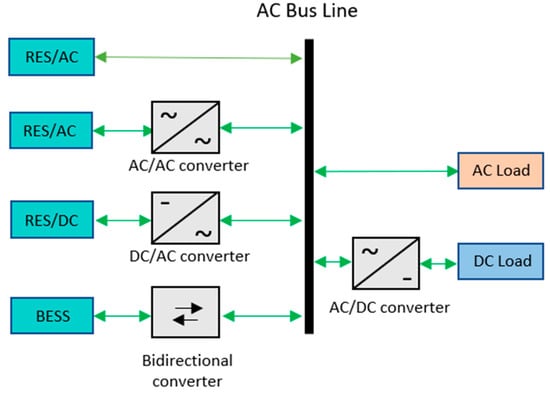
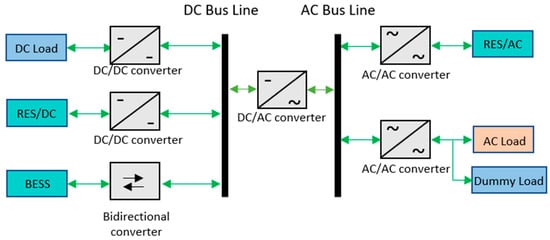
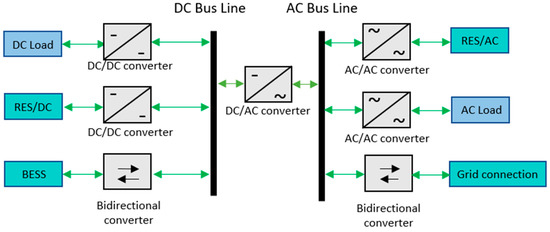
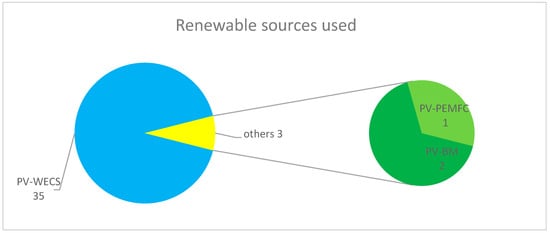
The HRES system can include a BESS (battery energy storage system) to improve reliability. The BESS stores electrical energy generated by renewable sources, such as solar panels or wind turbines, and uses it at times of high energy demand or when renewable energy generation is reduced due to weather factors. In summary, the BESS is a key part of the HRES system to ensure a reliable and sustainable energy supply. Table 1 shows the most used BESSs, their advantages, and disadvantages.
| BESS | Advantages | Disadvantages | Articles Related to BESS |
|---|---|---|---|
| Energy storage in compressed air (CAES) | Lower cost, low self-discharge, high service life. | High initial cost, large scale, there are geographical restrictions that limit the installation of the system. | Not found |
| Battery Ni–Cd | Low maintenance requirement, high energy density and high reliability. | This product has high costs and suffers from a phenomenon known as “battery memory”. | Not found |
| Battery lead–acid | This product has a medium energy density, low initial investment, and is widely available. In addition, it does not require a cell management system. | The characteristics of this product” include a low life cycle, low efficiency, ventilation requirements, and the need for proper disposal of used batteries. | [10][11][12][13][14][15][16][17][18][19][20][21] |
| Battery Li-ion | This product stands out for its high efficiency, high energy density, long life cycle, and relatively compact size. In addition, it is in an area where rapid technological advances are taking place. | The disadvantages of this product are its high initial capital costs due to the special packaging required and the potential risk of battery body rupture. | [22][23][24] |
| Hydrogen-based (HESS) | This product is almost contamination-free and has a wide power range. | This product includes low efficiency, low response time, high cost, and installation restrictions due to the hydrogen storage tank. | Not found |
| Supercapacitor (SESS) | It has high efficiency, long life cycle, and high power capacity. | It has a low energy density and a relatively high cost. | Not found |
| Flywheel (FESS) | It features high power capacity, long life cycle, and fast charging capability. | Disadvantages of this product include its high cost due to the need for a separate vacuum chamber, safety issues, high self-discharge, and high cost. | [25] |
| Gel batteries | This product is a good choice for applications that have high cyclic requirements due to its excellent recharge behavior, which gives it a long service life. | One of the disadvantages of gel batteries is that they have a lower current capacity compared to other battery technologies. They can be more expensive than some other battery technologies. | [26] |
These auxiliary sources are typically used when the main source cannot generate enough power to meet demand at times of high demand or when the main source is inactive or unreliable. Common examples of auxiliary generation sources are diesel or natural gas generators.
2.2. HRES Sizing and Optimization
| Criteria | Type | Limitations | Articles Related to the Criteria |
|---|---|---|---|
| Annual system cost (ACS) | Economic | The cost estimate does not consider the possible variation of the interest rate and inflation. | Not found |
| Net current cost (NPC) | Economic | It is not possible to take into account fluctuations in fuel prices (in case conventional energy sources are included) and uncertainties in the durability of system components such as batteries. | [1][6][11][12][13][14][15][16][17][18][19][21][23][24][25][26][27][28][29][30][31][32][33][34][35][36] |
| Cost of energy (COE) | Economic | The cost of recovering system components at the end of their useful life is not included. | [11][12][13][15][16][17][18][21][23][24][26][28][30][31][32][33][34][36][37][38][39][40] |
| Levelized cost of energy (LCOE) | Economic | The cost estimation tool does not take into account external factors, such as volatility in fossil fuel prices and inflation. | [1][19][22][24][25][27][29][41] |
| Total net current cost (TNPC) | Economic | Changes in the cost of energy are not taken into account. | Not found |
| Life cycle cost (LCC) | Economic | Cost estimation is complicated by the difficulty of accurately predicting acquisition, operation, and long-term maintenance costs, which can affect the accuracy of the life cycle cost (LCC) analysis. | [26][42][43] |
| Cost of loss of battery life (LLCB) | Economic | Reduced battery performance as the battery ages is not included in the evaluation. | Not found |
Table 3. Optimization criteria (reliability) and limitations for HRESs [3][5].
| Criteria | Type | Limitations | Articles Related to the Criteria |
|---|---|---|---|
| Probability of loss of power supply (LPSP) | Reliability | It is defined for a specific load profile and does not take into account variations in that load profile. | [1][28][39][40][41][44] |
| Expected energy not supplied (EENS) | Reliability | The potential impact of variation in load demand is not taken into account. | Not found |
| Level of autonomy (LA) | Reliability | Normalized-to-total annual energy demand. | Not found |
| La probabilidad de pérdida de carga (LLP) | Reliability | A limitation in the assessment of power supply reliability is that long-duration load loss (LLP) only measures the probability of power supply interruption and does not provide a complete assessment of the reliability of the power system as a whole. | [32] |
| Deficiency in probability of power supply (DPSP) | reliability | For EPG < EL, it is the same as LPSP. | Not found |
2.3. Optimization Algorithms
3. Summary
This entry is adapted from the peer-reviewed paper 10.3390/eng4020084
References
- Kharrich, M.; Kamel, S.; Abdeen, M.; Mohammed, O.H.; Akherraz, M.; Khurshaid, T.; Rhee, S.-B. Developed Approach Based on Equilibrium Optimizer for Optimal Design of Hybrid PV/Wind/Diesel/Battery Microgrid in Dakhla, Morocco. IEEE Access 2021, 9, 13655–13670.
- Dipti, D. A Review on Unit Sizing, Optimization and Energy Management of HRES. Int. J. Trend Sci. Res. Dev. 2018, 2, 419–426.
- Roy, P.; He, J.; Zhao, T.; Singh, Y.V. Recent Advances of Wind-Solar Hybrid Renewable Energy Systems for Power Generation: A Review. IEEE Open J. Ind. Electron. Soc. 2022, 3, 81–104.
- Nema, P.; Nema, R.K.; Rangnekar, S. A Current and Future State of Art Development of Hybrid Energy System Using Wind and PV-Solar: A Review. Renew. Sustain. Energy Rev. 2008, 13, 2096–2103.
- Singh, R.; Bansal, R.C. Review of HRESs based on storage options, system architecture and optimisation criteria and methodologies. IET Renew. Power Gener. 2018, 12, 747–760.
- Ganjei, N.; Zishan, F.; Alayi, R.; Samadi, H.; Jahangiri, M.; Kumar, R.; Mohammadian, A. Designing and Sensitivity Analysis of an Off-Grid Hybrid Wind-Solar Power Plant with Diesel Generator and Battery Backup for the Rural Area in Iran. J. Eng. 2022, 2022, 4966761.
- Alkafaji, A.S.; Al-Samawi, A.A.; Trabelsi, H. Hybrid Energy Storage Review for Renewable Energy System Technologies and Applications. In Proceedings of the 2021 18th International Multi-Conference on Systems, Signals & Devices (SSD), Monastir, Tunisia, 22–25 March 2021; pp. 1059–1067.
- Stecca, M.; Elizondo, L.R.; Soeiro, T.B.; Bauer, P.; Palensky, P. A Comprehensive Review of the Integration of Battery Energy Storage Systems into Distribution Networks. IEEE Open J. Ind. Electron. Soc. 2020, 1, 46–65.
- Sravan Kumar, B.; Ramesh, L. Review and Key Challenges in Battery to Battery Power Management System. In Proceedings of the 2019 5th International Conference on Computing, Communication, Control And Automation (ICCUBEA), Pune, India, 19–21 September 2019; pp. 1–5.
- Pourbehzadi, M.; Niknam, T.; Aghaei, J.; Mokryani, G.; Shafie-Khah, M.; Catalão, J.P. Optimal operation of hybrid AC/DC microgrids under uncertainty of renewable energy resources: A comprehensive review. Int. J. Electr. Power Energy Syst. 2019, 109, 139–159.
- Linn, S.; Ya, A.Z. Solar/Wind/Diesel Hybrid Energy System with Battery Storage for Rural Electrification. Int. J. Sci. Eng. Tech. Res. 2014, 3, 2172–2176.
- Ishraque, F.; Shezan, S.A.; Nur, J.; Islam, S. Optimal sizing and performance investigation of a solar-wind-battery-DG based hybrid Microgrid system applicable to the remote school of Bangladesh. Eng. Rep. 2020, 3, e12281.
- Ranjan, R.; Doda, D.K.; Lalwani, M.; Bundele, M. Simulation and Optimization of Solar Photovoltaic–Wind–Diesel Generator Stand-alone Hybrid System in Remote Village of Rajasthan, India. In International Conference on Artificial Intelligence: Advances and Applications 2019: Proceedings of ICAIAA 2019; Springer: Singapore, 2020; pp. 279–286.
- Yusuf, S.S.; Mustafi, N.N. Design and Simulation of an Optimal Mini-Grid Solar-Diesel Hybrid Power Generation System in a Remote Bangladesh. Int. J. Smart Grids 2018, 2, 27–33.
- Venkatachalam, K.M.; Saravanan, V. Techno economic environmental assessment of hybrid renewable energy system in India. Int. J. Adv. Appl. Sci. 2021, 10, 343–362.
- Shaahid, S.; El-Amin, I. Techno-economic evaluation of off-grid hybrid photovoltaic–diesel–battery power systems for rural electrification in Saudi Arabia—A way forward for sustainable development. Renew. Sustain. Energy Rev. 2009, 13, 625–633.
- Padrón, I.; Avila, D.; Marichal, G.N.; Rodríguez, J.A. Assessment of Hybrid Renewable Energy Systems to supplied energy to Autonomous Desalination Systems in two islands of the Canary Archipelago. Renew. Sustain. Energy Rev. 2018, 101, 221–230.
- Mikati, M. Modelado y Simulación de un Sistema Conjunto de Energía Solar y Eólica para Analizar su Dependencia de la Red Eléctrica. Rev. Iberoam. Autom. Inf. Ind. 2012, 9, 267–281.
- Saiprasad, N.; Kalam, A.; Zayegh, A. Comparative Study of Optimization of HRES using HOMER and iHOGA Software. 2018. Available online: https://www.semanticscholar.org/paper/841cc5d0a8de98ab80f1709b2e28de8d5dea767a (accessed on 16 February 2023).
- Vendoti, S.; Muralidhar, M.; Kiranmayi, R. HOMER Based Optimization of Solar-Wind-Diesel Hybrid System for Electrification in a Rural Village. In Proceedings of the 2018 International Conference on Computer Communication and Informatics (ICCCI), Coimbatore, India, 4–6 January 2018; pp. 1–6.
- Lin, C.E.; Phan, B.C.; Lai, Y.-C. Optimal Design of Hybrid Renewable Energy System Using HOMER: A Case Study in the Philippines. In Proceedings of the 2019 SoutheastCon, Huntsville, AL, USA, 11–14 April 2019; pp. 1–6.
- Khosravani, A.; Safaei, E.; Reynolds, M.; Kelly, K.E.; Powell, K.M. Challenges of reaching high renewable fractions in hybrid renewable energy systems. Energy Rep. 2023, 9, 1000–1017.
- Suman, G.K.; Yadav, S.; Roy, O.P. HOMER Based Optimal Sizing of a PV/Diesel/Battery Hybrid System for a Laboratory Facility. In Proceedings of the 2020 3rd International Conference on Energy, Power and Environment: Towards Clean Energy Technologies, Meghalaya, India, 5–7 March 2021; pp. 1–5.
- Manurung, D.; Dalimi, R. Optimization Electricity Supply for Thousand Island Jakarta Province by Using Hybrid Photovoltaic-Wind Turbine-Diesel Generator-Crude Palm Oil (CPO) Power Plant-Battery System. J. Phys. Conf. Ser. 2020, 1500, 012035.
- Combe, M.; Mahmoudi, A.; Haque, M.H.; Khezri, R. Cost-effective sizing of an AC mini-grid hybrid power system for a remote area in South Australia. IET Gener. Transm. Distrib. 2018, 13, 277–287.
- Thirunavukkarasu, M.; Sawle, Y. A Comparative Study of the Optimal Sizing and Management of Off-Grid Solar/Wind/Diesel and Battery Energy Systems for Remote Areas. Front. Energy Res. 2021, 9, 752043.
- Almutairi, K.; Hosseini Dehshiri, S.S.; Hosseini Dehshiri, S.J.; Mostafaeipour, A.; Issakhov, A.; Techato, K. Use of a Hybrid Wind—Solar—Diesel—Battery Energy System to Power Buildings in Remote Areas: A Case Study. Sustainability 2021, 13, 8764.
- Iosr, S.J.; Payal, R.; Saroj, M.A.; Arvind, M. Optimal Configuration of Wind/Solar/Diesel/Battery Hybrid Energy System for Electrification of Rural Area. IOSR J. Electr. Electron. Eng. (IOSR-JEEE) 2015, 10, 23–31.
- Roth, A.; Boix, M.; Gerbaud, V.; Montastruc, L.; Etur, P. A flexible metamodel architecture for optimal design of Hybrid Renewable Energy Systems (HRES)–Case study of a stand-alone HRES for a factory in tropical island. J. Clean. Prod. 2019, 223, 214–225.
- Singh, R.; Bansal, R.C. Optimization of an Autonomous Hybrid Renewable Energy System Using Reformed Electric System Cascade Analysis. IEEE Trans. Ind. Inform. 2018, 15, 399–409.
- See, A.M.K.; Mehranzamir, K.; Rezania, S.; Rahimi, N.; Afrouzi, H.N.; Hassan, A. Techno-economic analysis of an off-grid hybrid system for a remote island in Malaysia: Malawali island, Sabah. Renew. Sustain. Energy Transit. 2022, 2, 100040.
- Sari, A.; Majdi, A.; Opulencia, M.J.C.; Timoshin, A.; Huy, D.T.N.; Trung, N.D.; Alsaikhan, F.; Hammid, A.T.; Akhmedov, A. New optimized configuration for a hybrid PV/diesel/battery system based on coyote optimization algorithm: A case study for Hotan county. Energy Rep. 2022, 8, 15480–15492.
- Gonzalez, F.J.G.; Salazar, I.V.; Gomez, A.P.-N. Comparison of Optimization Methods for Hybrid Renewable Energy Systems. In Proceedings of the 2019 IEEE International Conference on Engineering Veracruz (ICEV), Veracruz, Mexico, 14–17 October 2019; Volume I, pp. 1–6.
- Krishan, O. Sathans Design and Techno-Economic Analysis of a HRES in a Rural Village. Procedia Comput. Sci. 2018, 125, 321–328.
- Akram, U.; Khalid, M.; Shafiq, S. Optimal Sizing of a Wind/Solar/Battery Hybrid Grid-Connected Microgrid System. IET Renew. Power Gener. 2018, 12, 72–80.
- Sharma, K.K.; Gupta, A.; Kumar, R.; Chohan, J.S.; Sharma, S.; Singh, J.; Khalilpoor, N.; Issakhov, A.; Chattopadhyaya, S.; Dwivedi, S.P. Economic evaluation of a hybrid renewable energy system (HRES) using hybrid optimization model for electric renewable (HOMER) software—A case study of rural India. Int. J. Low-Carbon Technol. 2021, 16, 814–821.
- Shezan, S.K.A.; Saidur, R.; Hossain, A.; Chong, W.T.; Kibria, M.A. Performance Analysis of Solar-Wind-Diesel-Battery Hybrid Energy System for KLIA Sepang Station of Malaysia. IOP Conf. Ser. Mater. Sci. Eng. 2015, 88, 012074.
- Suresh, V.; Muralidhar, M.; Kiranmayi, R. Modelling and optimization of an off-grid hybrid renewable energy system for electrification in a rural areas. Energy Rep. 2020, 6, 594–604.
- Muleta, N.; Badar, A.Q. Designing of an optimal standalone hybrid renewable energy micro-grid model through different algorithms. J. Eng. Res. 2023, 11, 1737.
- Gupta, S.; Bohre, A.K.; Sawle, Y. Techno-economic scrutiny of HRES through GA and PSO technique. Int. J. Renew. Energy Technol. 2018, 9, 84.
- Xu, Y.-P.; Ouyang, P.; Xing, S.-M.; Qi, L.-Y.; Khayatnezhad, M.; Jafari, H. Optimal structure design of a PV/FC HRES using amended Water Strider Algorithm. Energy Rep. 2021, 7, 2057–2067.
- Zhu, C.; Liu, F.; Hu, S.; Liu, S. Research on capacity optimization of PV-wind-diesel-battery hybrid generation system. In Proceedings of the 2018 International Power Electronics Conference (IPEC-Niigata 2018 -ECCE Asia), Niigata, Japan, 20–24 May 2018.
- Afrouzi, H.N.; Hassan, A.; Wimalaratna, Y.P.; Ahmed, J.; Mehranzamir, K.; Liew, S.C.; Malek, Z.A. Sizing and economic analysis of stand-alone hybrid photovoltaic-wind system for rural electrification: A case study Lundu, Sarawak. Clean. Eng. Technol. 2021, 4, 100191.
- Kartite, J.; Cherkaoui, M. Study of the different structures of hybrid systems in renewable energies: A review. Energy Procedia 2019, 157, 323–330.
- Vishakha, V.; Vardwaj, V.; Jadoun, V.K.; Jayalaksmi, N.; Agarwal, A. Review of Optimization Techniques for Hybrid Wind PV-ESS System. In Proceedings of the 2020 International Conference on Power Electronics & IoT Applications in Renewable Energy and its Control (PARC), Mathura, India, 28–29 February 2020; pp. 202–207.
